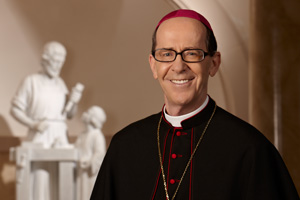

Several years ago, Eric M. Johnson explained how God used music to turn his life around. He wrote in This Rock Magazine, “When people ask me about my conversion today, I often tell them I was converted by Mozart. That is an exaggeration, but not far from the truth. It was through music and art that I encountered a positive, inspiring vision of Catholicism. …it was through my ears and eyes that I first became attracted to the faith.” Johnson goes on to explain that, as a teenager, he had formed deep prejudices against the Catholic Church. Nonetheless, when given a recording of Gregorian chant at the age of 17, something began to change as a result of listening: “Whatever the reason, I played it often, intrigued by the otherworldly stillness it brought to my soul. My reservations about the Catholic Church softened as I listened to it. No institution that nurtured such beauty could be all bad.”
In this case of conversion, the beauty of sacred music turned Johnson toward God, lifted him above confused thinking and attuned his soul to the Truth that sets us free. Such beauty has the power to lift us above our humdrum lives and carry us to transcendent realms. Beethoven said: “Art demands that we not stand still.” When we listen to good music, when we view the Pieta of Michelangelo, when we encounter the saint living life itself beautifully, we cannot resist its power to move us towards the source of beauty. It puts us in touch with God.
In previous issues of The Catholic Sun, we have looked at seven tasks Catholics need to be doing in order to bear witness to Christ at this time in America. These seven tasks include:
- Trust the truth;
- Live God’s plan for marriage;
- Be pure of heart;
- Make Sunday the center of our life;
- Defend the dignity of all persons;
- With charity promote the common good; and
- Be merciful and fearless.
I shall conclude this series not by reflecting any further on these important tasks, but by looking at the power of beauty to lead us to Jesus who is, as St. Paul writes (Col 1:15) “the image of the invisible God.”
Modernism’s turn toward the ugly
If beauty has the power to lead us to God, then, why have so many people stopped believing in it? We cannot be blind to the proliferation of bad art that has materialized since the age of the enlightenment or to the assaults on beauty that have become commonplace in America and Europe, especially in the past century. Think, for example, of the Brooklyn Art Museum’s display, a few years ago, of a Madonna made from elephant dung and pornographic images. All too prevalent are the iconoclastic assaults of modernism on beauty within popular music, art and architecture. Much modern art strikes us not as beautiful at all but as a mere self-assertion of the artist himself. This is a sign of poverty of spirit.
Hans Urs von Balthasar explained the problem in this way: when the transcendent is denied and belief in God mocked, then beauty cannot survive; ugliness is inevitable. Science and technology become artificially exalted while the most beautiful of God’s earthly creation, human beings, are discarded as trash. Von Balthasar writes: “Whenever the relationship between nature and grace is severed… then the whole of worldly being falls under the dominion of ‘knowledge,’ and the springs and forces of love immanent in the world are overpowered and finally suffocated by science, technology, and cybernetics. The result is a world… in which power and the profit-margin are the sole criteria, where the disinterested, the useless, and the purposeless is despised, persecuted and in the end exterminated – a world in which art itself is forced to wear the mantle of technique.”
Why this turn in modern art toward the ugly and away from beauty? Two reasons are often proposed. The first of these reasons relates to the proliferation of violence, seduction and other evils that have reached such catastrophic proportions that it is hard for some to believe that goodness and beauty are more than a façade. Especially in the wake of historical tragedies such as Auschwitz, the Gulag, Rwanda and 9/11, many in the intellectual and artistic spheres contend that to believe that God is good and beautiful flies in the face of reality. Truth seems to demand a focus on horror and ugliness.
Secondly, the God who became man, and especially His Church, do not look beautiful to a number of our contemporaries. This is not exactly new. In the famous “Suffering Servants songs” of the Prophet Isaiah, God’s inspired word describes the Messiah in terms that seem far from beauty (Is 53:2-3), “There was in him no stately bearing to make us look at him, nor appearance that would attract us to him. He was spurned and avoided by men,… one of those from whom men hide their faces.”
For many today, then, ugliness is the fact of life; beauty a figment of the imagination, a weak construct which cannot withstand the crushing reality of human life on planet earth. But can human beings truly live without beauty? St. Augustine discovered, after searching in fruitless ways for many years, that God made us for Himself and the human heart remains restless until it rests in Him. Only when it rests in Him does it discover a beauty of depth and wonder beyond all imaginings.
The paradoxical beauty of Christ
The prophecy of Isaiah is true when it describes the battered face of Jesus as He carried the cross. But the prophetic description of Him found in Psalm 45 is also true where it says (Ps 45:3-4): “Fairer in beauty are you than the sons of men; grace is poured out upon your lips… Gird your sword upon your thigh, O mighty one! In your splendor and your majesty ride on triumphant.”
These two prophecies are not contradictory, but paradoxical. Together they keep us from a shallow notion of beauty that remains on the surface, and invite us to move beyond external beauty to interior beauty of the heart, and ultimately to the beauty of God Himself. As Pope Benedict wrote (“On the way to Jesus Christ,” p. 39), “In the Passion of Christ the… experience of the beautiful has received a new depth and a new realism. The One who is beauty itself let Himself be struck in the face, spat upon, crowned with thorns… Yet precisely in the Face that is so disfigured, there appears the genuine, the ultimate beauty, the beauty of love that goes ‘to the very end’ and thus proves to be mightier than falsehood and violence.”
Through His Church, the Lord Jesus beckons men and women of every place and time to believe in the beauty of His love and to begin already to taste it with joy. This beckoning is accomplished through the Church’s Liturgy with its sacred music, art and architecture, through the ministry of charity and action for justice, through the pursuit of holiness in Marriage, Holy Orders, Consecrated Life and all vocations in the Church.
Our Pope Emeritus wrote (Idem, p. 40-41), “Christian art stands between two fires today (and perhaps this has always been the case), which say that everything else, anything beautiful, is a deception and that only the depiction of what is cruel, base, and vulgar is the truth and true enlightenment. And it must withstand the deceptive beauty that diminishes man instead of making him great… Nothing can bring us into contact with the beauty of Christ Himself more than the world of beauty created by faith and the light that shines upon the faces of the saints, through which His own light becomes visible.”
For the Church, then, to evangelize popular culture, we must rejoice in the beauty of Christ, bear witness to Him with charity, courage and the splendor of truth, and draw life each day from the summit and fountain of love that is the Sacred Liturgy. We can have great confidence that true beauty, like true light, is unperturbed to make its appearance in the dark.





![[VIDEO] Make Sunday feel like Sunday again](https://www.catholicsun.org/wp-content/uploads/2021/04/2021-YOUTUBE-BISHOP-MESSAGE-THUMBNAIL-ENGLISH-218x150.png)